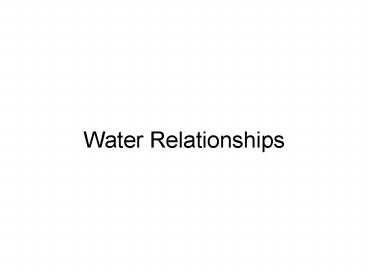Water Relationships - PowerPoint PPT Presentation
1 / 35
Title:
Water Relationships
Description:
Water Conservation by Plants and Animals. Water and Salt Balance in Aquatic Environments ... Additional water is absorbed in the cloaca. Water Summary ... – PowerPoint PPT presentation
Number of Views:56
Avg rating:3.0/5.0
Title: Water Relationships
1
Water Relationships
2
Outline
- Water Availability
- Water Content of Air
- Water Movement in Aquatic Environments
- Water Movement Between Soils and Plants
- Water Regulation on Land
- Water Acquisition by Animals
- Water Acquisition by Plants
- Water Conservation by Plants and Animals
- Water and Salt Balance in Aquatic Environments
3
- Water Availability
- Water moves from greater to lesser concentration
- Relative concentrations of water
- In air relative humidity
- In water osmolarity or salinity
- Balance of water gain and loss impacts survival
of organisms in a particular environment.
4
- Evaporation Loss of Water from Organism to
Atmosphere - Important for terrestrial organisms
- Provides cooling
- Represents major loss of water.
- Greatest in dry climates water vapor in air
less where humidity is lower - Concentration gradient greater
- Cooling from evaporation greatest in dry climates.
5
- Dry Environment
- Great water pressure deficit
- High saturated vapor pressure (air could hold a
lot of water) - Low actual vapor pressure
- Greater movement of water from organism to
environment
6
Evaporative Water Loss
7
- Dew
- Condensation of water on surfaces cooled by
radiation of heat to atmosphere - Impacted by absolute humidity amount of water
vapor in atmosphere - Fog Forms at dew point on nucleation sites,
small particles - Important source of moisture in summer along
California coast some other dry environments
8
(No Transcript)
9
(No Transcript)
10
(No Transcript)
11
- Water Movement in Aquatic Environments
- Water moves down concentration gradient by
diffusion. - Water is more concentrated in freshwater
environments than in the oceans. - Aquatic organisms can be viewed as an aqueous
solution bounded by a selectively permeable
membrane floating in an another aqueous solution - Osmosis special case of diffusion - water
movement across a membrane.
12
- Water concentration in solutions
- Osmolarity a measure of concentration of
dissolved substances in water - Salinity concentration of dissolved salts - salt
water solution contains relatively less water
than fresh water - That means ?
- Water moves from area of less dissolved salts to
more dissolved salts
13
- Concentration of solutes and cells
- Hyperosmotic or Hypertonic more dissolved
substances outside cell like a pickle - water leaves the cell ? crenation
- Hypoosmotic or Hypotonic less dissolved
substances outside - water enters the cell ? cell swells and bursts
- Isoosmotic or Isotonic same concentration
inside and out, the cell is at dynamic
equilibrium
14
(No Transcript)
15
(No Transcript)
16
- Organisms must maintain cellular/tissue
osmolarity within narrow limits - Osmoregulation
- Adapted to particular osmotic environment
- Generally water moves in and out of cells freely
- Salt movement is restricted due to charged nature
of salt ions
17
(No Transcript)
18
- Water and Creatures in Terrestrial Environments
- Terrestrial organisms face (2) major challenges
- Evaporative loss to environment.
- Reduced access to replacement water.
19
- Water and Plants
- Earliest plant lived in moist habitats
- No means to transport water within structure
- Required moisture film for reproductive processes
- Later plants developed vascular system
- Movement by transpiration
20
- Water moves from soil to top of plant in unbroken
stream - Transpiration provides the pull
- Rate of transpiration is regulated by action of
guard cells - gt 90 of water taken in by roots is lost to the
atmosphere - Adaptations include reduced leaf area,
modifications to leaf surface
21
Dermal Tissue
- The epidermis of a plant is often covered with a
thick waxy layer called the cuticle
- Guard cells
- Paired cells with openings between them (stomata)
- Allow gas exchange
22
Guard cells turgid
Guard cells flaccid
23
Water Regulation on Land - Plants
24
- Plant adaptations
- Root system development
- Low growth habit (reduced wind exposure)
- Hirsute leaves
- Leaf coloration
25
Water Acquisition by Plants
- Extent of plant root development often reflects
differences in water availability. - Deeper roots often help plants in dry
environments extract water from deep within the
soil profile. - Park found supportive evidence via studies
conducted on common Japanese grasses, Digitaria
adscendens and Eleusine indica.
26
(No Transcript)
27
(No Transcript)
28
Water Regulation on Land - Animals
- Wia Wd Wf Wa - We - Ws
- Wia Animals internal water
- Wd Drinking
- Wf Food
- Wa Absorbed by air
- We Evaporation
- Ws Secretion / Excretion
29
Water Regulation on Land - Animals
30
(No Transcript)
31
(No Transcript)
32
- Physiological Regulation of Tissue-Water Balance
in Animals - Kidneys evolved to produce hypertonic uring in
terrestrial organisms - Other mechanisms exist as well eg. Certain sea
birds
33
Osmoregulation in Animals
- Osmoregulation is the regulation of the bodys
osmotic (water and salt) composition - Adaptation to dry terrestrial habitats produce
hypertonic urine - Insects Malpighian tubules Active transport of
K, water is drawn osmotically, reabsorbtion in
the hindgut - Vertebrates Kidneys
- Hydrostatic filtration (blood under pressure)
- Selective reabsorption
- Mammals, birds produce hypertonic urine
34
- Marine birds (Procellarids) minimize water loss
by excreting salt through specialized glands - Additional water is absorbed in the cloaca
35
- Water Summary
- Number of unique properties due to chemical
nature - Concentration of water drops as percent salt in
solution rises - Movement of water from greater to lesser
concentrations occurs by specialized diffusion
osmosis - Development of various strategies to deal with
water has lead to patterns of distribution of
species of plants and animals































